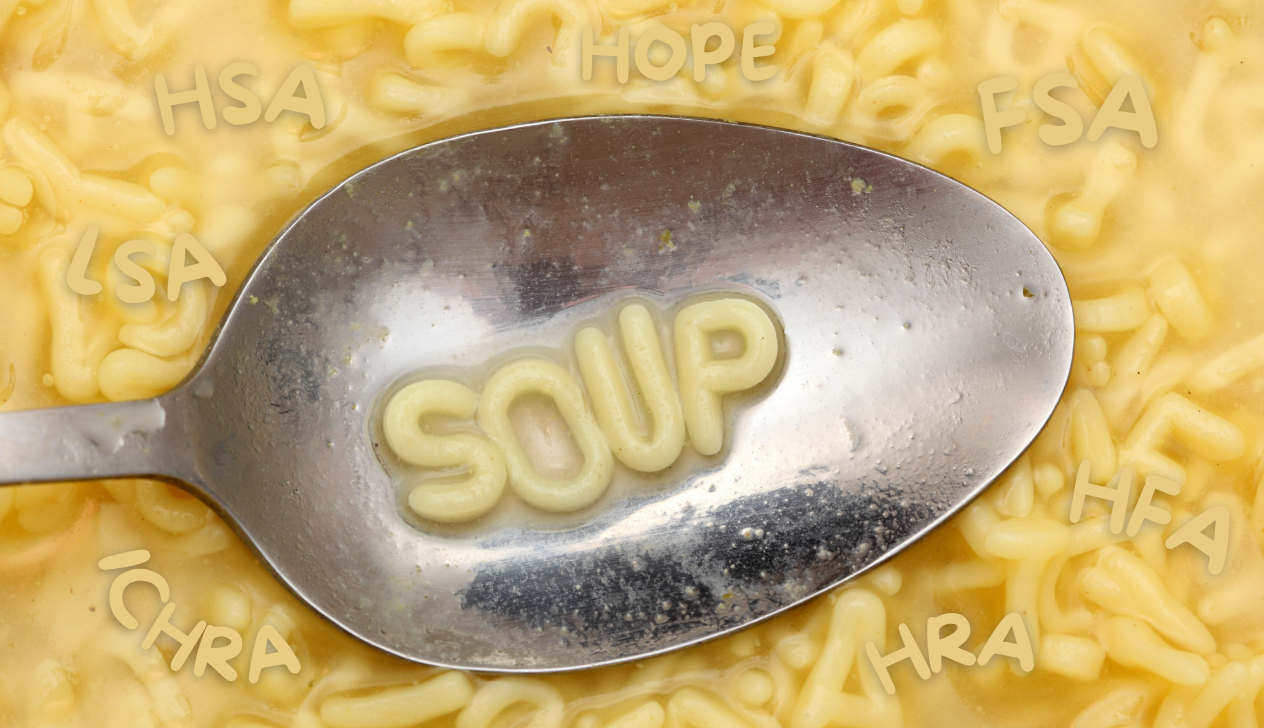The Alphabet Soup of Consumer-Driven Benefits
The Old, the New and the Proposed

Consumer-driven benefit accounts can be a confusing alphabet soup of acronyms and terms. While many are familiar with FSAs, HSAs, and HRAs, the emergence of new accounts like ICHRA and LSA, as well as proposed ones like USA and HFA, adds complexity to an already intricate landscape.
Checking in on the 'Old'
FSAs, HSAs and HRAs have been available for decades now, but there is still some confusion and misinformation that surrounds their use.
Health Flexible Spending Accounts (Health FSA)
- Defining Characteristics: You must make an election before the start of the plan year. The full election for a Health FSA is available on the first day of the plan year. You have a defined period to use the funds (which may include an extended period or limited rollover). Funds can be used on all qualified medical expenses (as defined by IRS) and must be verified (or substantiated) as eligible. Once an election is made, it cannot be changed, except for certain life events.
- When to Use: You have predictable or expected medical, dental, vision or out-of-pocket expenses. You have known expenses early in the year and could benefit from access to full election. You are not enrolled in a qualified HSA-plan and/or you are not eligible for an HSA.
- When to Skip: You are contributing to an HSA. You do not have predicted medical expenses. Situations where employee turnover is high.
Health Savings Accounts (HSA)
- Defining Characteristics: You must be enrolled in an HSA-eligible health plan, you cannot be covered by ineligible plans and cannot be enrolled in Medicare. HSAs have a triple tax benefit in which funds are deposited pre-tax, grow tax-deferred and remain tax-free when used for qualified medical expenses. Funds are owned by the individual, automatically roll from year-to-year, and are never lost due to changes of employment or coverage. You can make changes to your HSA contributions at any time for any reason (up to the IRS limits).
- When to Use: You are enrolled in HSA-eligible health plan and are otherwise eligible to contribute to an HSA
- When to Skip: You are not eligible for an HSA (ie. you have other ineligible coverage, you are enrolled in Medicare).
Health Reimbursement Arrangements (HRA)
- Defining Characteristics: HRAs must be offered with a group health plan and allow employers to set allocate funds for employees' out-of-pocket medical expenses. The specific rules, contributions, and timing are defined by the employer or plan sponsor.
- When to Use: Employers do not have an HSA-eligible health plan but want to help employees with out-of-pocket expenses. Can be used in collective bargaining agreements or as step into higher deductible plans. A post-deductible HRA can be used in conjunction with an HSA to reduce high out-of-pocket exposure for those that need it most.
- When to Skip: You are offering an HSA and/or no employer funding will be provided for out-of-pocket expenses.
Familiarize yourself with the 'new'
In recent years, we have seen a drive towards personalized benefits through the use of ICHRA and LSA.
Individual Coverage Health Reimbursement Arrangements (ICHRA)
- Defining Characteristics: An ICHRA is a defined contribution benefit. An employer sets rules defining how much they will contribute. An employee can use the funds to pay individual health plan premiums and, in some cases, to pay for out-of-pocket expenses.
- When to Use: Employers are turning to ICHRA for a number of reasons which may include: offering coverage that was not previously offered, expanding who has access to coverage, expanding choice among employees, and managing cost increases.
- When to Skip: You are offering a group health plan coverage which meets the needs of employer and employees.
Lifestyle Spending Accounts (LSA)
- Defining Characteristics: Lifestyle Spending Accounts are generally a taxable benefit where an employer has decided to set aside funding for a specific purpose(s) or a targeted, high-value benefit for employees. LSAs are not an IRS regulated account, so they do not have strict rules and situations governing their use.
- When to Use: Employers are turning to LSAs to offer customizable benefit solutions to meet a variety of employees' needs through a simplified administrative approach.
- When to Skip: You are unable to invest in a new benefit program and/or you are looking to offer a highly prescriptive benefit program.
Get a pulse on the 'proposed'
While it is still a guessing game regarding what will happen, there have been a few concepts introduced in the current or prior Congress which provide some clues. Many of the concepts recognize limitations with HSAs and look to expand availability through different trade-offs.
Health Freedom Accounts (HFA)
Proposed by Rep Chip Roy (R-TX), Healthcare Freedom Act of 2025 would establish Health Freedom Accounts (HFA). HFAs would be built upon the foundation of an HSA but would have several key differences. First, anyone could have HFAs regardless of their health plan coverage. Proposed contribution limits and catch-up amounts would be significantly increased from current HSA levels. HFAs could be used to reimburse premiums and would expand other eligible expenses. However, there would be a trade-off. As proposed, the employer exclusion for health insurance would be phased out. This would have a significant change to how health insurance is purchased today.
Universal Savings Accounts (USA)
Universal Savings Accounts (USA) were introduced in the last Congress and would allow individuals to make contributions up to $10,000 (increasing with inflation) on a tax-free basis. Any distributions from the account would be includible in gross income. The amount allowable would be phased out for higher income levels. Rather than advancing incremental improvements and expansion efforts to the existing alphabet soup of accounts, a USA takes a more simplistic approach by offering a single account that could be used across a variety of expenses.
HOPE Accounts
Health Out-of-Pocket Expense Act or HOPE Act was introduced in the last Congress and would establish the use of HOPE Accounts. HOPE Accounts would be similar to a Roth IRA for healthcare expenses. Through a HOPE Account, funds would be taxed when contributed but receive favorable tax treatment on the growth and when used for eligible medical expenses. Individuals would be required to have minimum essential coverage in order to enroll and contribute to a HOPE account (but would not be required to have an HSA-qualified health plan as is required for an HSA).
The Power of Understanding
Understanding the landscape of consumer-driven benefit accounts can be daunting, but with clarity comes the power to make informed decisions. FSAs, HSAs, and HRAs remain fundamental tools for managing medical expenses, each with its unique advantages. Meanwhile, newer accounts like ICHRA and LSA offer personalized benefits tailored to individual needs. Keeping an eye on proposed accounts such as HFA, USA, and HOPE, which promise to further evolve the benefits landscape, is crucial. By staying informed, employers and employees can make the most of these opportunities to enhance their financial well-being and healthcare security.
Are you a benefits advisor exploring how consumer-driven benefits might fit into your strategy or looking to build trust and credibility through thought leadership? Schedule a free discovery call to learn how Angel Vision can support you on your journey.


